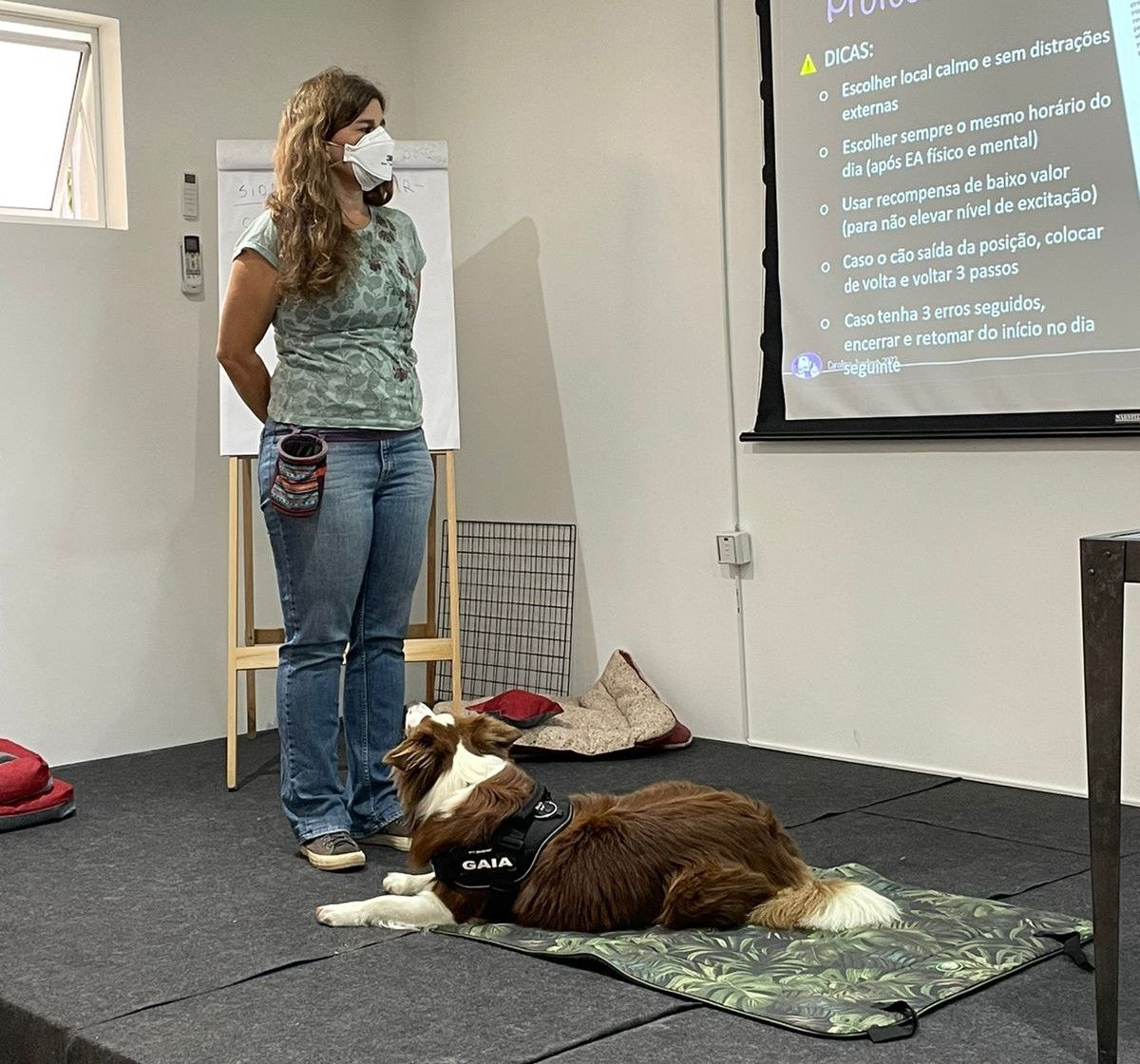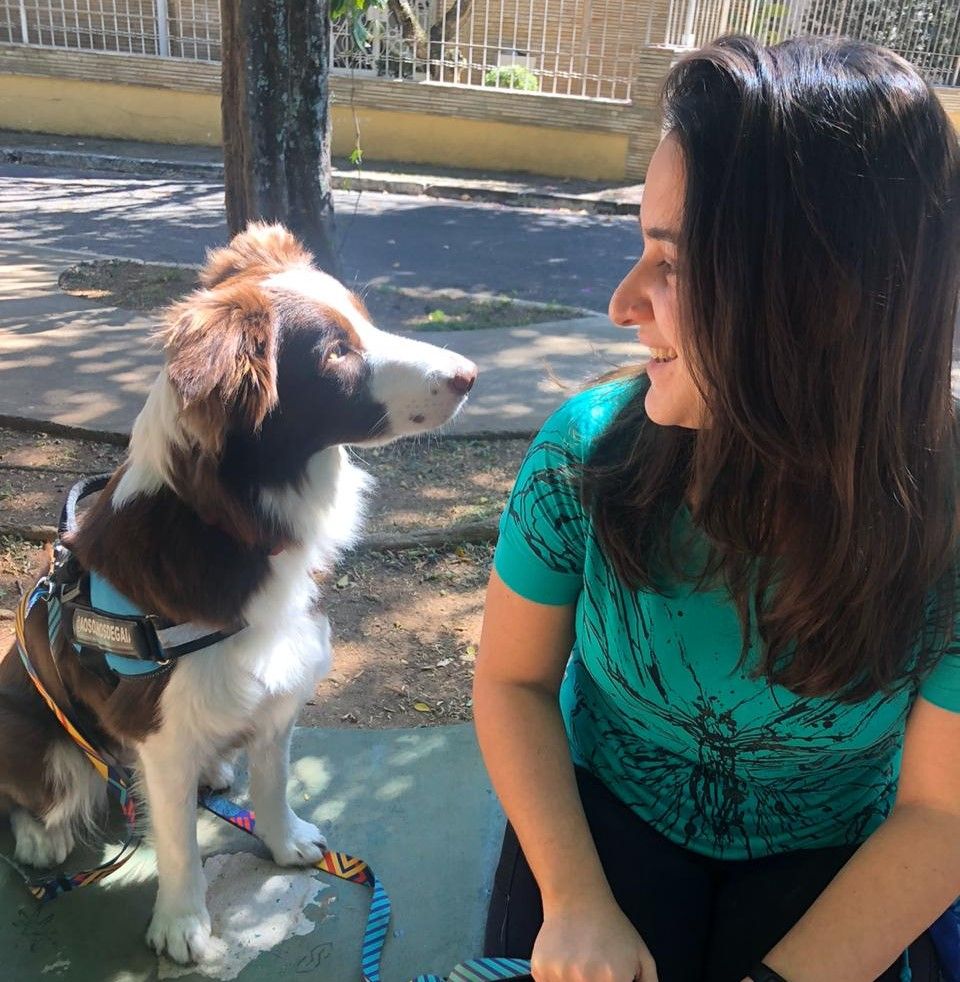Beyond obedience: why do we choose positive training?

When we decided to get a Border Collie, we knew that our routine would change and that it would be a big challenge, so even before Gaia arrived we searched for information about dog training - we took several online courses, bought all the necessary items and were confident that we could handle everything. But when she finally arrived, Gaia turned our routine upside down. She was a very cute puppy, but with LOTS of energy, she herded and bit us, peed around the house and didn't like to be alone, which made me freak out a little.
That was when we decided to seek professional help. We had no experience with dog training, so we came across several options of professionals, with different approaches. We realised that this choice would directly define what kind of relationship we would build with Gaia.
Of course, some of our goals were for her to be educated, to respect the house rules, to pee and poo in the right place, to learn a few tricks and to "behave well" when we needed her to. But that wasn't enough. We also wanted her to be a balanced, confident dog who felt safe with and respected by us. We didn't want a relationship of obedience and submission, we wanted a relationship of respect and cooperation.
And the only way to align all this was through positive training.
What is positive training?
But after all, what exactly is positive training (also known as force-free training)? Gaia's trainer, Carolina Jardim, a Brazilian psychologist, postgraduate in Animal Behaviour, dog trainer and founder of Turma do Focinho, explains it as follows:
"Positive training means, in reality, educating without causing fear or pain, i.e. teaching without the use of positive punishments (to decrease behaviours we don't want, such as jumping on people, pulling on walks, digging holes, biting etc.) and without the use of negative reinforcements (to increase behaviours we do want, such as sitting, staying, lying down, walking together etc.). Instead, only positive reinforcement (such as treats, food, toys, affection, praise, walking etc.) is used to increase the frequency of desired behaviours and, as a last resort, negative punishment is used to decrease the frequency of undesired behaviours (by withdrawing attention and frustrating the dog in the unwanted behaviour)." [1](free translation from Portuguese)
She goes on to say that "positive training goes way beyond positive reinforcement, it calls for a new way of looking at our own reality and also the dog’s reality, similar to looking through a magnifying glass and analyzing our choices, impulses and motivations. Science-based education for our dogs requires us to question our own ethics and ponder our actions and their consequences. Positive training is basically teaching the dog what we want so that it can learn to make good choices in pivotal situations." [2]
But does it really work?
Punitive or mixed trainers still use myths, such as dominance and pack leader, to justify the use of aversives in dog training. According to these myths, dogs, like wolves, organise themselves in hierarchical pack structures and, therefore, humans have to put themselves in the position of alpha leaders to "show who is the boss", putting the dog in a place of submission.
It turns out that the experiments that supported these theories have been proven incorrect and outdated. And this is not just my opinion or that of positive trainers, but a fact proven by several recent scientific studies on the subject [3].
Also, punitive and mixed trainers usually criticise positive training, saying it doesn't work with large or aggressive dogs. They also say that dogs trained with positive reinforcement have no boundaries and "do whatever they want". But, again, the latest scientific studies show the opposite: dogs trained only with the force-free methods are more well-behaved than dogs trained with punishments and dogs whose owners use punishments are more likely to develop behavioural issues, such as fear and aggression. [4]
So yes, it has been scientifically proven that positive training is not only effective but also the most efficient way to teach your dog, particularly when dealing with intricate and sensitive behavioural issues like reactivity and aggression.
Carolina Jardim reinforces that "regardless of the size, temperament or breed of your dog, all can be trained with methods that do not involve pain or fear, to learn desired behaviours and learn family rules and limits. Positive education is not about not giving limits or being permissive. What the dog that learns without pain or fear does need is consistency, coherence and persistence." [1](free translation from Portuguese)
Benefits of positive training
In addition to being a scientifically proven method for training dogs, positive training also brings many benefits to your dog's well-being and for strengthening your relationship with him. Some of them are:
- Building a Trusting Relationship
Force-free training is built on a foundation of trust and respect. By focusing on positive reinforcement techniques, such as rewards and praise, you establish a bond based on cooperation and trust with your dog.
- Effective and Reciprocal Communication
Communication is a two-way street. Dog training is not just about teaching your dog to understand what you want from him. To establish effective communication, you also need to understand your dog's needs. A tool often used in positive training is knowledge of dog body language. Dogs communicate with us all the time and positive training helps us understand what they are saying. This allows you to move forward with training while respecting the dog's boundaries and also allows you to remove the dog from any situation that is uncomfortable for him.
- Promoting Emotional Well-being
Unlike punitive methods, positive training prioritises your dog's physical and emotional well-being. By avoiding the use of punishment, aggression, fear, pain or intimidation, you will create a safe learning environment, reducing anxiety and allowing your dog to feel comfortable to develop mentally and emotionally.
- Meeting the Dog's Basic Needs
Positive training goes beyond simple tricks and obedience: it aims at promoting changes in your dog's behaviour and emotions. Through this method, it is possible to teach impulse control and good manners, but also to change a dog's emotions in the face of a stimulus or trigger. Positive training is also concerned with establishing a routine that fulfils your dog's basic needs while enriching their environment. This positive influence extends beyond the training sessions, creating a more balanced dog in all situations.
- Versatility and Adaptability
Force-free training methods are adaptable to various breeds, ages, and temperaments. Whether you have a playful puppy or an older dog, positive reinforcement techniques can be tailored to suit individual needs and personalities. The versatility of force-free training allows you to address specific challenges, modify behaviours, and teach a wide range of commands, ensuring a well-rounded education for your dog.
- Strengthening the Human-Canine Bond
Training sessions become valuable and fun experiences, which enable you and your dog to develop a deeper connection and understanding of each other. Your dog will associate training with enjoyable moments spent together, strengthening your bond and establishing a positive rapport.

How to find a positive trainer?
The profession of dog trainers is not yet regulated, which makes it very tricky to find qualified and ethical professionals.
It is not easy to identify dog trainers that use punitive methods, as they do not usually open up about the methods used in the first approach. However, if a trainer tells you that you will not participate in the training process at the beginning, uses words like "behaviour correction", "dog control", "submission", "alpha leader", or recommends scolding, using a slip leads, spraying water on the dog or using a tin can with coins in it, etc., run away!
It is important to know that true positive trainers will never use aversive tools, will always prioritise the dog's well-being, will involve you in the whole training process and will respect your dog's boundaries.
Before hiring a professional, ask questions, talk to other clients and seek information about the trainer's work. It's okay to be demanding and enquiring, after all, your dog's welfare is at stake.
Conclusion
When it comes to your dog's education, positive training is the ethical and effective choice. If there is a method that works, is science-based and prioritises the well-being of the dog, strengthening the human-dog bond, there should be no more room for the use of aversives in dog training.
[1] Carolina Jardim. A Educação de um cão. Available at: <https://www.turmadofocinho.com/educacao-de-um-cao/>
[2] Carolina Jardim. Being alone: the challenge of the century. Available at: <https://www.turmadofocinho.com/being-alone-the-challenge-of-the-century/>
[3] Amber LaRock. Why ‘Alpha Leader’ Training Has Been Debunked In Dogs. Available at: <https://iheartdogs.com/why-alpha-leader-training-has-been-debunked-in-dogs/>
[4] Zazie Todd. Positive Reinforcement and Dog Training VII: Summary and Conclusions. Available at: <https://www.companionanimalpsychology.com/2012/08/positive-reinforcement-and-dog-training.html#:~:text=Two separate questionnaire studies by,such as fear and aggression>
